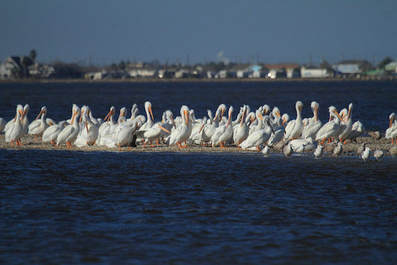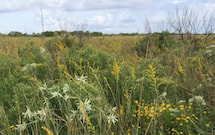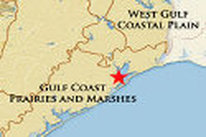A coastal prairie at the intersection of urban expanse and rural beauty.shared from www.nature.org1/30/2018 Roughly 40 miles south of Houston, the Galveston Bay area bustles with activity; ships come and go at some of the busiest ports in the world, shrimpers, oystermen and fishermen prepare their nets, and tourists stroll through the scenic streets of Galveston. And in Texas City, a city of more than 45,000 that is situated on the southwest shoreline of Galveston Bay, The Nature Conservancy is working diligently to improve the health of the Gulf of Mexico, protect freshwater and preserve habitat for one of North America’s most endangered birds. Established in 1995 thanks to a $2.2 million land donation from the Mobil Oil Company (now ExxonMobil), the Conservancy’s Texas City Prairie Preserve is 2,303 acres of coastal prairie at the intersection of urban expanse and rural beauty. The coastal grasslands found here are vital to the natural resilience of the Gulf Coast—prairies and marshlands act as a natural buffer during storms and hurricanes, absorbing and dispersing water from storm surges and floods. The sponge-like qualities of the prairie are also important for filtering the freshwater that flows into the Gulf of Mexico—more than three million gallons enter the Gulf from the Mississippi River alone. In order to mitigate the impacts of excessive land subsidence and restore the preserve’s surrounding marshlands and coastal prairie, the Conservancy has partnered with the Texas General Land Office, U.S. Fish and Wildlife Service and the Galveston Bay Estuaries Program to implement a series of living shoreline projects. Over the last half-century, the shoreline at Texas City Prairie—along with much of the Galveston Bay area—has become more vulnerable to wave action and land loss due to subsidence, which occurs when excessive amounts of groundwater have been withdrawn from an aquifer. Once that occurs, the layers of clay within the aquifer compress and settle, which lowers the ground surface area from which the groundwater is being pumped. Once that groundwater water has been removed from the sediment, it cannot be replaced. Without intervention, the land in and around Galveston Bay will continue to settle, leading to an aggressive loss of coastal prairie and associated wetlands—something the region cannot afford to lose. The wetlands at Texas City Prairie support migratory and year-round populations of waterfowl, shorebirds and wading birds and the preserve provides a home for wintering and migrating grassland songbirds. Birds such as the brown pelican, white ibis, peregrine falcon, white-tailed hawk, Forster's terns, and seaside sparrows routinely inhabit the preserve. In addition to coastal resiliency projects, the Conservancy also grazes cattle as a land management tool—something that has occurred on the coastal prairieland since the late 1800s. And through the use of prescribed burning, the Conservancy staff has returned natural fire to the landscape. Native preserve plants include big and little bluestem, yellow indiangrass, switchgrass, eastern gammagrass, gulf cordgrass and the rare coastal gayfeather; but woody plants that invade the prairie and non-native species such as Chinese tallow trees and deeply rooted sedge pose a serious threat to coastal prairies and are being eliminated. For more information or to learn about volunteer opportunities, contact the Texas City Prairie Preserve office: 4702 Highway 146 North, Texas City, TX 77590. Phone: (409) 941-9114.
0 Comments
Leave a Reply. |








 RSS Feed
RSS Feed